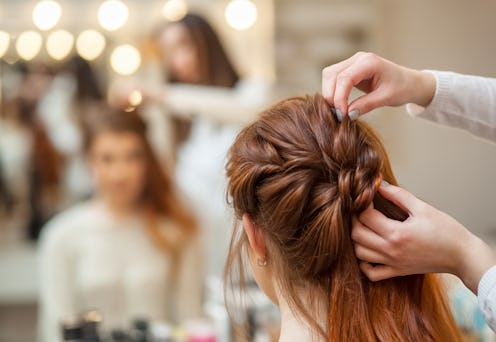Beauty
The Beginner's Guide To French Braids Vs. Dutch Braids
Experts lay it all down.

Braids are one the most versatile — and easiest — ways to style your hair. You can wear box braids as a protective style for weeks or rock an intricate, one-night-only look (there’s a reason why everyone’s favorite celebrities love braids for a red carpet moment). The options are endless and there’s a braided hairstyle that looks amazing on pretty much everyone.
Two popular looks, French braids and Dutch braids, often get mixed up. While similar in look and technique, there is a slight difference. To get a complete guide on both, Bustle asked celebrity hairstylist Angela C. Stevens and TRESemmé global stylist Justine Marjan to explain how to tell the difference between the two and break down a step-by-step guide on how to do each one.
What’s The Difference Between A French & Dutch Braid?
The TL;DR: a French braid is accomplished when each section of hair is crossed over the middle piece when braiding while a Dutch braid is crossed under. The braids also differ in appearance. “The two braiding techniques are similar but they differ based on the direction the hair is manipulated in, resulting in a different visual outcome,” says Stevens. “The French braid appears flat and the Dutch braid appears raised,” adds Marjan.
How To Do A French Braid
Stevens says that a French braid is a braid that looks inverted. “[It’s] where the hair is divided into 3 sections and crosses over alternating pieces to make a connection on the head braid,” she says.
First, section the hair you want to braid into three sections. Stevens then says to cross them over one another, while alternating the pieces. Once those three pieces intersect, you’ll start grabbing pieces of hair as you braid.
Marjan says to grab the right section with your right hand, then cross your right hand over the middle piece and put it into your left hand, making sure you grab another piece of hair to add to the braid as you go. Then cross the piece from your left hand to your right hand, still making sure you grab hair as you cross over. Continue this pattern down the length of hair.
Pro tip: Stevens recommends using a pomade or an edge control gel, like the Cantu Extra Hold Edge Stay Gel, to manage frizz. She says to apply as needed to the base of the hair to help manage frizz and flyaways. She also recommends hydrating hair with a good serum. Try a smooth product like the TRESemmé Keratin Smooth Keratin Infusing Smoothing Serum or Crown Affair The Hair Oil to nourish strands.
How To Do A Dutch Braid
Similar to the French braid, you’ll want to separate hair into three sections. Start from the right and cross the piece under the middle section instead of crossing it over like you would when doing a French Braid. As you cross, you’ll still want to remember to add more pieces of hair each time you braid. Then from the left side, Marjan says to cross the piece from your left hand under the middle strand, passing it into your right hand. Continue this pattern all the way down the length of hair.
Once you practice, doing French and Dutch braids is pretty easy and you can make it one of your go-to hairstyles to keep your hair out of your face.